My wife came home with some limes from the grocery store one day nine years ago and I said, “We shouldn’t be buying those. I can grow those.”
That’s how I ended up planting our Bearss lime tree back in 2012.
In this profile, I’ll tell you a bit more about my own tree and about Bearss limes and trees in general, the goal being threefold: to help you decide whether it’s a good tree to add in your yard; to give you some background and context on the variety if you have it already; and, for those who recently purchased a house with unknown citrus trees in the yard, to help you identify whether one of them is a Bearss lime.
The fruit
What kind of lime is a Bearss lime? It can get almost as big as a lemon.
And it’s seedless.
Bearss limes are distinguished from the other main kind of lime grown in California called the Mexican, West Indian, or Key lime. These are also known as Bartender’s limes. They are much smaller, rounder, and they’re usually seedy. (See the page for Mexican lime at U.C. Riverside’s Citrus Variety Collection.)
Bearss limes go from green to light green on the peel once they’re mature.
Harvest season
Many limes are dropping from my tree right now, late January. Winter is when Bearss lime trees usually have the most fruit ready to pick; however, since the tree blooms a little throughout the year, there are at least a few limes ready to be picked almost year-round.
The tree
When I bought my Bearss lime tree in 2012 I knew that I would keep it pruned small. I grew up around citrus trees and saw that really, only one family per neighborhood should grow a lime or lemon tree. No single family can use a large lime or lemon tree’s full crop. But if I kept my lime pruned small, I figured we could get the amount of limes our family needed and no more.
I was wrong. I have kept the tree pruned down to shoulder height, yet it still makes more limes than we can use.
When I prune my tree I shear it. (The smell of the chopped leaves is wonderful!) There is no thought involved as to where to cut a branch. Because of that, and because the tree is so short, my children — including my three-year-old daughter above — usually help me prune.
I cut it back in size about twice each year, once here in late winter and again sometime in summer.
My tree looks more like a bush because of my pruning, but an unpruned Bearss lime tree has the “wild hair” branches that citrus trees often get, and it grows up to 10, 12, even 15 feet.
Bearss lime trees have thorns but the thorns are small.
Mexican/Key limes have bigger thorns. (Although there is a thornless Mexican lime, too.) The leaves of a Mexican/Key lime are smaller though.
The leaves of a Bearss lime are large like the leaves of an orange tree, but the edges of the Bearss leaves are deeper lobed.
Lime trees in general are more sensitive to cold temperatures than orange trees. A couple times, the new growth on my Bearss lime tree has been frosted back by nights in the mid-20s. But such temperatures never affected fruit nor older leaves or branches. On those same nights, the fruit and older leaves and branches of some nearby avocado trees were damaged.
Variety history
It makes sense that Bearss lime trees aren’t as tender as the avocados in the cold considering where Bearss originated. According to Robert W. Hodgson in The Citrus Industry, Volume 1, Bearss started in 1895 in the Central Valley town of Porterville where a nurseryman named T.J. Bearss grew the original seedling. The tree may have been grown from a seed from a lime of Tahitian origin.
The Bearss lime is sometimes called a Tahiti lime. Hodgson explains: “The name Tahiti arises from the fact that this type of lime was introduced in California from Tahiti sometime during the period of 1850 to 1880.”
Let me complicate things with one other name. So the Tahiti is a type of lime whose botanical name is Citrus latifolia, and the Bearss lime is one cultivated variety of this type. However, this type of lime is also sometimes called Persian. Why Persian? Hodgson again: “The origin of the name Persian is unknown, however, although it seems likely that this fruit came to the Mediterranean area via Persia.”
All limes “are believed to have originated in northeastern India, adjoining portions of Burma, or northern Malaysia and to have followed the same general path westward to the Mediterranean basin and thence to the Western Hemisphere.” (The Citrus Industry, Volume 1.)
Anyway, these Persian or Tahitian types of limes have been grown in California for a long time and they are the standard lime for our region. The original 1954 edition of the Sunset Western Garden Book only lists Bearss as a recommended variety of lime to grow in California.
Is a Bearss lime tree a good fit for your yard?
I can’t imagine being dissatisfied with a Bearss lime tree unless you wanted the small Mexican/Key limes for specific uses and didn’t have space for both trees.
As I mentioned earlier, I planted our Bearss so my wife didn’t have to buy limes. But nowadays, I use more limes than she does. Because they are at hand and abundant, I’ve grown to love their smell and taste, and I’ve found new uses for them. I add lime juice to salsas. As a snack, the kids and I slice limes in half to lick. I squeeze some lime juice in a bowl of water to use to wipe down the kitchen counter, and my desk, and the interior of our cars. I make salads of cabbage, avocado slices, and a lime squeezed over the top.
Oh, and the bees sure make use of the Bearss lime’s blossoms in winter, as they are one of the earliest blooming citrus in our yard.
No wonder Bearss has been the standard California lime for over a century.
All of my Yard Posts are listed HERE

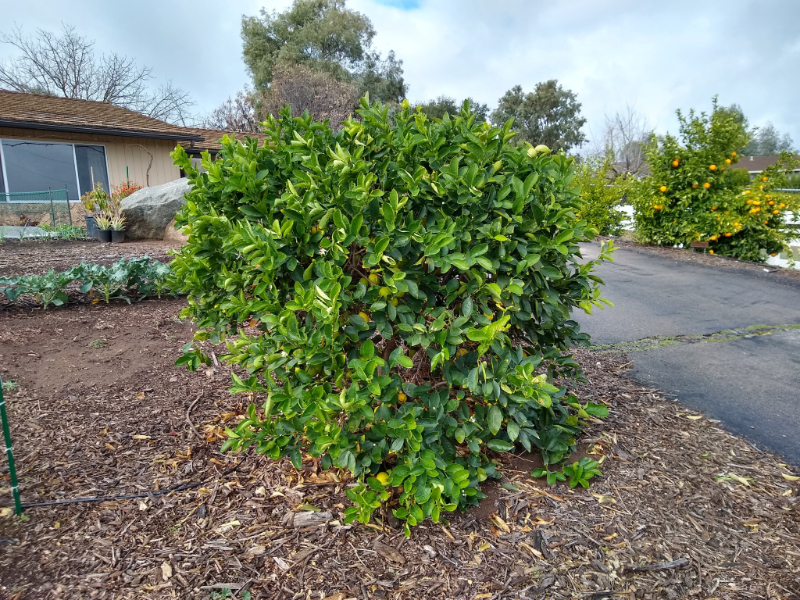
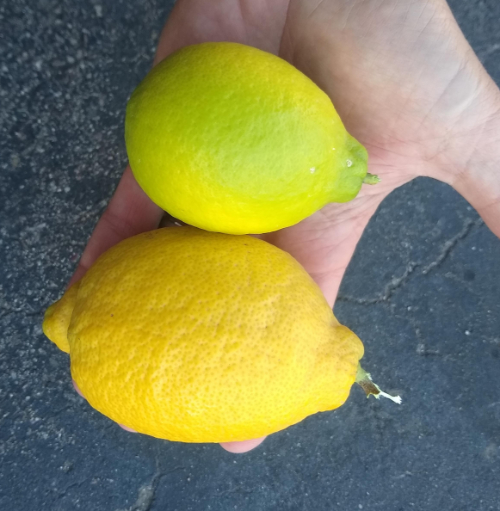
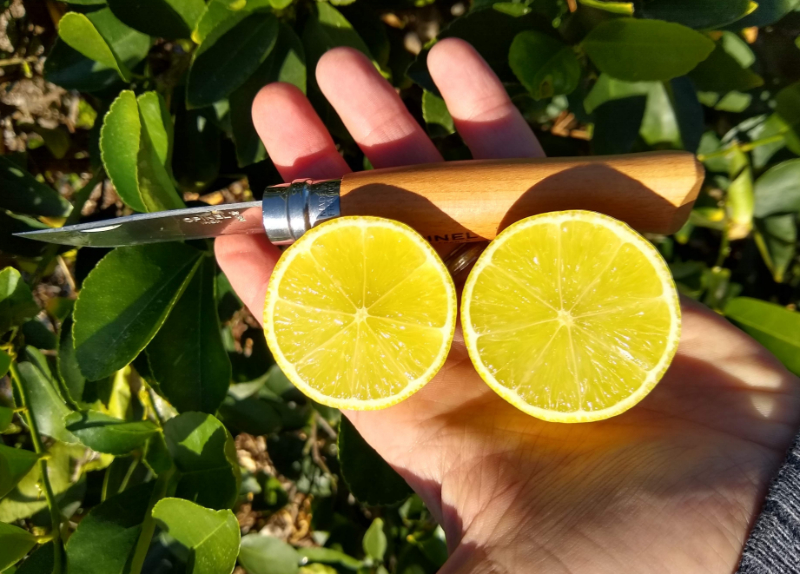
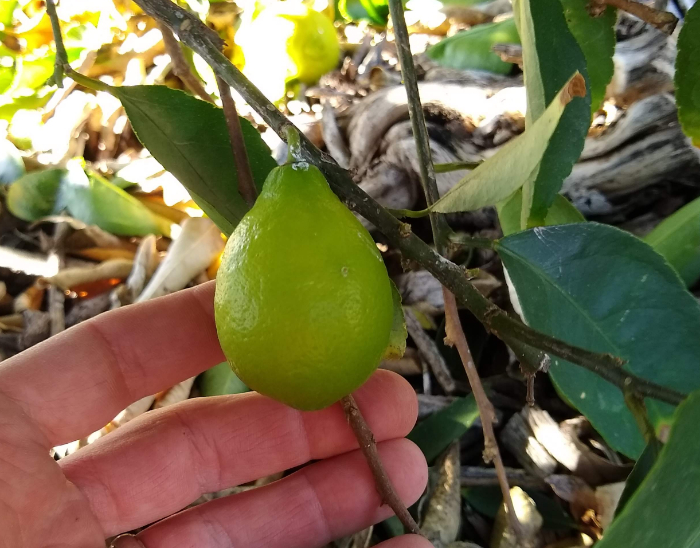
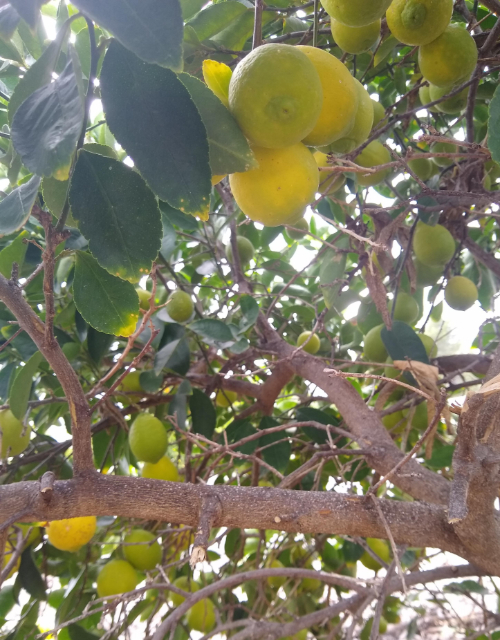

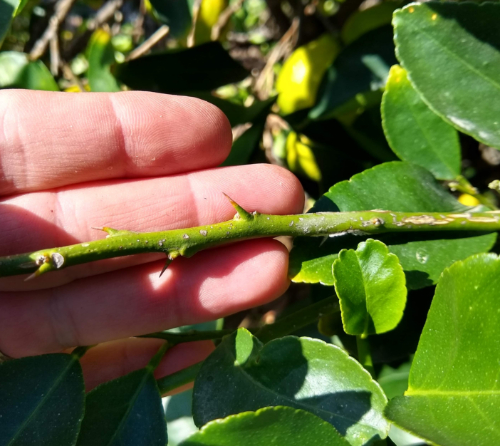
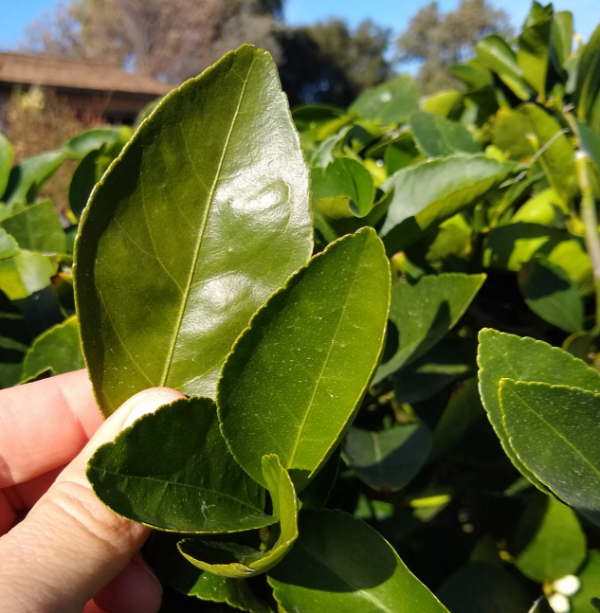
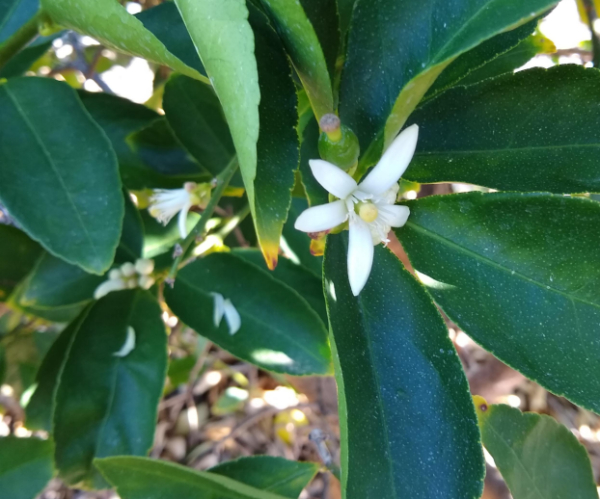


Hello Greg, I planted a bearss (5gallon) last spring so almost a year, also a cocktail grapefruit and both trees leaves have yellowed considerably! I don’t believe it’s too much watering as the ground is not saturated at all. Even the eureka lemon in the area doesn’t look too hot, while other citrus in other areas of my yard are thriving. Any suggestions?
Hi Rich,
It could just be the time of year. Some citrus trees at my place also get a bit yellow in the winter while others don’t. But they always green up when the weather warms up. This is said to be caused by a nitrogen deficiency related to the cold soil so it’s not necessarily solved by fertilizing.
If yours are extremely yellow and dropping, then it might be something else, something more serious such as a root disease. I hope that’s not it.
Thank you Greg! Always look forward to your helpful information!
Spray them with a copper solution…
Hey Greg, great information about Bearss limes. Every year I have a bumper crop from only having one tree. Tree was called a dwarf when bought 20 years ago although it stands about 10ft high. The only repeating problem I have is about 10% of fruit have a sticky white residue on the surface at the stem usually with ants. What causes that condition?
That’s usually a sign of mealybugs.
I had the most beautiful, productive lime tree. It started out as one of those tiny trees from the big box store. It provided limes twice a year and the foliage was beautiful for 10 years. It began to die back, starting from the outer-most branches. I trimmed back the dead stuff and it tried really hard to come back, but all the new growth died. So sad..
Hi Greg,
Thank you for your goodwill for those interested in fruit farming. I have a small, a sort of kitchen garden where I have three lemon trees.All of them have some or other infection. One was a lime tree , the plant purchased from a reliable source. It was growing very well. Suddenly the leaves started yellowing and I do not know if it will survive now. It will be happy if you can give me any advice
Hi Benu,
Thank you very much. Sudden yellow leaves on your lime? There are so many possibilities. One way to narrow down the possibilities is to consider the pattern of yellowing on individual leaves. Is an entire leaf uniformly yellow, or are there seemingly random yellow spots, or are there yellow areas only between the veins?
Also, which leaves on the tree are yellowing? Is it only new, small leaves? Is it only old, large leaves?
And always check the undersides of leaves. That’s where sapsucking insects will usually be found. As they feed on leaves, the leaves yellow in those areas.
Finally, consider how old the tree is. Citrus trees older than about ten years are less likely to suddenly get yellow leaves for the first time because of a watering problem or nutrient deficiency, or even because of an insect pest outbreak. In my observations, these older trees usually decline due to a disease affecting their roots (diseases caused by phytophthora or armillaria, for example).
As for you in Nepal, however, you might be dealing with citrus issues that I’ve never even heard of let alone seen.
My post “Reading citrus leaves” might be helpful here, but it’s not as comprehensive as it could be. I’ll continue to add to it.
Hi Greg,
Thank you for your prompt reply.
My plant is only about three years old. Few old leaves at the bottom are Ok.
I did not see any insect underneath. I suspect probably it has some micronutrient deficiency. Anyway I will go through your information and see what can be done.
Thank you.
Dr.Benu B Karki
This is a cool article about cover crops helping with HLB.
https://civileats.com/2020/01/22/can-cover-crops-save-floridas-citrus/
Thanks for sharing that, John. I hope it turns out that increased soil organic matter and soil life reduces the impact of HLB in other places too.
Hi Greg,
Wondering if you have any comments/recommendations for growing citrus now that they’ve found HLB-harboring Asian citrus psyllids in Fallbrook? https://www.countynewscenter.com/state-and-county-investigate-citrus-disease-in-fallbrook/
No infected trees found (yet). But is it just a matter of time?
Any news about when the UCR-discovered finger lime peptide will be commercially available? https://news.ucr.edu/articles/2020/07/07/uc-riverside-discovers-first-effective-treatment-citrus-destroying-disease
I have about 20 citrus trees and I’m wondering if I should step up the insecticide treatments or just tent them all (my HOA won’t be happy…). Maybe you could do a post on this topic and give some advice for residential citrus growers on what steps/products we should be thinking about, and which ones are available without a pesticide applicator license.
Thanks!
Hi Jane,
I did mention HLB in this recent post: https://gregalder.com/yardposts/saving-the-parent-washington-navel-orange-tree/
I’m pretty quiet on the topic because I don’t feel like I have anything insightful or helpful to share, unfortunately. I just finished attending a webinar about HLB/ACP this morning given by researchers in Florida and Texas, in fact. But I still don’t have many thoughts on it.
As you probably know, Florida is 100 percent infected with the disease. I can share that one of the Florida researchers mentioned that they are looking to the future in these ways: HLB-resistant rootstock/scion combinations, genetically engineering resistance into citrus, and growing citrus under tents.
A couple years ago, a citrus researcher here in California told me that tenting trees is really the only way to completely prevent a tree from infection. She suggested that we home growers do that if we want certain protection for our trees.
Pesticide treatments don’t prevent infection. They do reduce ACP populations but they also reduce the populations of predators and parasitoids that keep ACP populations down. In fact, the Texas researcher in the webinar this morning said that they buy and release these beneficial insects at least once a year because their pesticide treatments kill so many beneficials. There’s no free lunch; there are lots of trade offs.
I don’t know what anyone else should do with their citrus trees right now. I wish I had advice, but I don’t. For what it’s worth, I’ll tell you that I’m doing nothing with my citrus trees to directly combat Asian citrus psyllids (and thereby HLB) as of today: no pesticides, no tents, nothing else.
I do observe my trees closely though, and I haven’t seen the numbers of ACP increase since I first saw them on my trees a handful of years ago. And I have been fighting Argentine ants with more dedication over the past year or two. Studies have shown that reducing Argentine ant populations reduce the populations of all citrus insect pests, including ACP. I’ll write a post on the Argentine ant battle in the next few months.
Thanks, Greg.
I don’t know why I’m so worried about HLB…there are worse things in this world than losing my citrus trees. 🙂
In case you’re interested, the UCR professor who discovered a treatment for HLB published her results: https://pubmed.ncbi.nlm.nih.gov/33526689/
A post on ants would be great. It’s a constant battle. I look back fondly on the days of Diazinon, when I could apply it outside once a year and be done with it.
Hi Jane,
Thanks for the link!
I don’t know, Jane, losing a citrus tree is pretty horrible. I have almost two dozen fruit trees, and I’m pretty attached to them, having grown them for the past 25 years. This spring I lost a 20-year-old thornless Mexican lime. It was a fantastic producer until it dropped all of its leaves never came back. 🙁 The arborist specializing in fruit trees couldn’t see any evidence of pests or disease in the tree, roots or soil. It might have been old age, or, since Mexican limes are very picky about temperature and moisture, an adverse reaction to several days of rain we had in February (Los Angeles County). Unfortunately I can’t find ANY Mexican Limes to replace it–none of the growers have any in stock now. In the meantime, I’m wondering whether the Bearss us more available, and how its flavor compare to the Mexican lime? Is Bearss the same as limes you get at the supermarket?
Hi Greg,
Just found your site and your content is spot on! I spent a few hours reading through all your post!!
I have a 2 year old bearss lime tree that is struggling in some unique ways. Currently I have new blossoms on one half of the tree and the other half of tree lost all the leaves. Since owning the tree I have not received a full crop, only 1 or 2 limes. Would love to send you a pic of tree to get some of your thoughts and I can elaborate on my maintenance program for this tree. Thanks!
Hi Damion,
That is an odd behavior. You can post links to photos on a sharing platform like IMGUR or Google Drive.
Hi Greg, I planted a bearrs lime 3 years ago from a 5 gal grow pot, it has grown substantially each year but has yet to bear any fruit, last year it bloomed and fruits developed but dropped. Not sure if it’s because the high winds and gusts here. Would love your thoughts… thanks
I planted a Bearss lime tree in a large pot over a year ago. It’s also grown substantially and the leaves look healthy, but it still hasn’t produced any fruit.
just want to make sure the bearss lime is not a sweet lime, these are more like lemons correct? thanks in advance.
Yes, Bearss limes are sour like lemons.
I planted my bearss lime tree 3 years ago and it only produced limes the first year. I fertilized with citris fertilizer twice a year but no fruit. The tree continues to grow. What am doing wrong?
I have a citrus tree that was supposedly a Baerrs lime. It was kept in a pot for it’s first years, then moved to the ground as part of a xeriscaped yard. It constantly dropped it’s leaves after transplanting but they have grown back by early spring. I have been supplementing with an iron, zinc, and magnesium liquid supplement for the past two years which has noticeably reduced the leaf yellowing and drop. The fruit first appears as round or elongated lemon like fruit, but progresses to an orange rind, with medium orange size. The inner fruit is green, tastes like lime, but is not seedless. The tree also has numerous large thorns. Has this tree lost the Baerrs graft and reverted to root stock?
Sounds like it, Bud. Check these posts for some additional info on that:
https://gregalder.com/yardposts/beware-of-rootstock-suckers-on-citrus-trees/
https://gregalder.com/yardposts/grafting-onto-citrus-rootstock-suckers/